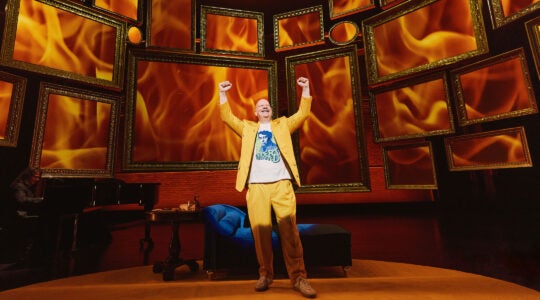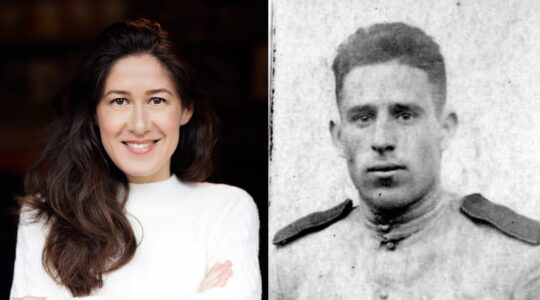Samuel Fuller held the distinction of being the only Hollywood filmmaker/GI who participated in the liberation of a Nazi concentration camp at the end of World War II. Already in his early 30s, Fuller (whose family name was changed from Rabinowitz before he was born) had logged several screenwriting credits before he volunteered in the wake of Pearl Harbor; his mother would send him a 16mm movie camera while he was overseas with the 1st U.S. Infantry, and with it he shot footage of his buddies, of the brutal combat he endured over the course of four years and, inevitably, of the camp at Falkenau.
That previously unseen footage is at the heart of “A Fuller Life,” a new documentary about the late writer-director made by his daughter Samantha Fuller. Opening Aug. 6, it’s a brisk, colorful and vividly entertaining piece of work, much like the man himself and, at 80 minutes in length, it has something of the breakneck pace of one of the maestro’s own B movie roller-coaster rides.
After a brief, slightly awkward prologue in which Ms. Fuller introduces herself and the premise of the film, what follows is a combination of an impressive list of cinema luminaries, including several actors who worked with Sam and a distinguished mini-directors guild of his colleagues, reading from his deliriously candid autobiography, “A Third Face”; they are juxtaposed with footage from Fuller’s own feature films and rare archival footage from his private collection. (The lilting jazz score was created by Fuller’s nephew, Paul Alexander Fuller; Sam’s widow, Christa Lang-Fuller, is executive producer, so this is really a family affair.)
Fuller famously spent his childhood working his way into the newspaper business, moving up the ladder from newsboy to personal copy boy to the legendary editor Arthur Brisbane, to boy crime reporter and protégé of Gene Fowler. Even as a kid fascinated by the detritus of the crime beat, the young Fuller had a burgeoning social conscience, spurred by repeated assignments to cover electrocutions at Sing Sing Prison. Eventually, he would decide to strike out on his own as a freelancer, just as the Depression devastated the country. The film offers a striking portrait of the young Fuller working his way across the country, covering the Ku Klux Klan, the 1934 General Strike in San Francisco and the grim daily lives of men and women crushed by economic forces they could neither understand nor control.
Gradually, Fuller realized that he needed images to accompany his words — something more nuanced than his otherwise deft cartooning could produce — and acquired a small still camera in a pawnshop. It was then that he realized that he needed “not just any image but the precise image.” Whether he knew it at the time or not, he was taking his first steps towards film directing.
The heart of the film, quite rightly, is Fuller’s recounting of his war experiences. Perhaps more than any other combat veteran who returned to Hollywood, Fuller was shaped by those experiences. The late British film historian Phil Hardy wrote that every Fuller film is a war film, whether in the guise of a western, a crime film or an adventure. That meshes nicely with the man’s own assessment of the war: “The biggest crime story of the Century.”
At heart, Fuller never stopped being a tabloid journalist in the best sense; a man who could calmly proclaim, “War itself is organized insanity,” was nobody’s fool. He had survived three devastating amphibious landings — North Africa, Sicily and Normandy — and saw things that no human being should have seen, culminating in his first film footage of the local German civilian population being forced by GIs to bury mountains of the dead in the concentration camp. He would recreate that day on which he was “mesmerized by the impossible” in his 1980 masterpiece “The Big Red One.”
“A Fuller Life” never touches directly on Fuller’s Jewish identity, although he had written about it in several passages of his memoir. But Jewishness is tacitly imprinted on the film. Fuller exhorts himself to “be a mensch” and towards the end of the movie, talking about his discomfort with the Hollywood mainstream and his lifelong commitment “to the Jeffersonian democratic ideal of equality for all,” he dryly observes, “I remain to this day an outsider.”
“A Fuller Life” will play at the Museum of Modern Art (11 W. 53rd St.) Wednesday, Aug. 6-16, along with a generous selection of archival prints of Fuller’s work, including “I Shot Jesse James,” his first feature as a director, “The Steel Helmet,” “Merrill’s Marauders” and the 2004 restored version of “The Big Red One.” For information, call (212) 708-9400 or go to www.moma.org.
The New York Jewish Week brings you the stories behind the headlines, keeping you connected to Jewish life in New York. Help sustain the reporting you trust by donating today.




